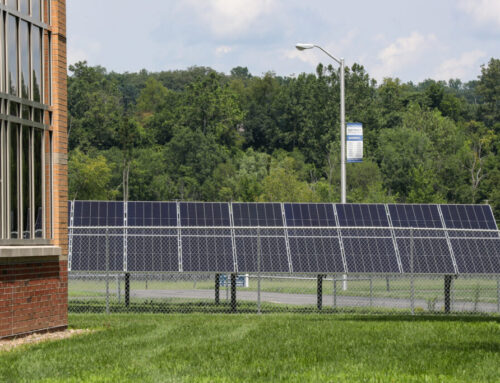Renewable Natural Gas Gains Interest From Fleets
November 14, 2025

Clean Energy Fuels has been expanding production of RNG sourced from dairy farms to serve as a fuel for the transportation industry. (Clean Energy Fuels)
November 14, 2025 9:58 AM, EST
Key Takeaways:
- The use of natural gas as a fuel for heavy-duty trucks is receiving a boost, due in part to the rollout of a more powerful natural gas engine and the growing availability of renewable natural gas to reduce emissions.
- Fuel savings with natural gas counter the higher equipment cost over time, but the price spread between natural gas and diesel can be difficult to predict.
- Natural gas suppliers are increasingly developing and expanding production by building plants at landfills and dairy farms.
[Stay on top of transportation news: Get TTNews in your inbox.]
The use of natural gas as a fuel for heavy-duty trucks is receiving a boost from a combination of recent developments, including the rollout of a more powerful natural gas engine from Cummins Inc., the growing availability of renewable natural gas to further reduce greenhouse gas emissions, and the embrace of both by fleet operators such as UPS Inc.
“The introduction of the Cummins X15N 15-liter natural gas engine significantly enhances UPS’s utilization of natural gas and renewable natural gas,” said Ryan Bankerd, corporate director of automotive sustainability at UPS. “This allows us to deploy compressed natural gas tractors on our most demanding longhaul routes that were previously reserved for diesel vehicles.”
Bankerd noted that deploying natural-gas-fueled trucks requires partnerships among carriers, truck makers, fueling system manufacturers, maintenance providers and natural gas suppliers.
He said the two best practices for RNG adoption are “fostering strong relationships with energy providers, who can source RNG upstream and deliver it reliably and cost-effectively; and maintaining close partnerships with vehicle providers, who collaborate to resolve any challenges as the technology continues to evolve.”
Bankerd explained that achieving a competitive total cost of ownership remains paramount for any low-carbon or advanced technology vehicle.
“Although this may vary by fleet, UPS has found TCO for RNG adoption to be favorable and positive compared to diesel or battery-electric vehicles,” he said. “Like with any other advanced technologies, including BEVs, there are infrastructure issues that may need to be addressed, but UPS benefits from decades of experience in navigating and solving for those kinds of challenges.”
UPS ranks No. 1 on the Transport Topics Top 100 list of the largest for-hire carriers in North America.
Meanwhile, Paper Transport Inc. is awaiting delivery of trucks that it spec’d with the Cummins X15N engine, “but we have not actually run one, other than a test,” said Jared Stedl, the fleet’s chief commercial officer.
The truckload carrier has used Cummins’ 9-liter and 12-liter natural-gas engines for years, and today operates about 80 natural-gas powered units.
Cummins began full production of its X15N natural gas engine in late 2024. (Cummins)
Noting that there is “a lot of excitement” about the 15-liter engine, Stedl said it gives the carrier and its drivers more horsepower, and expects it to perform better in locations that have more elevation gain.
However, fleets still need to overcome higher equipment costs when investing in natural gas trucks.
“The same challenges exist in terms of adoption, regardless of the engine,” he said. “We do believe that the TCO is higher.”
Trucks equipped with a 15-liter engine have a higher price point, Stedl noted, which he attributed to a combination of the engine, the tractor and the natural gas fuel delivery system.
Fuel savings with natural gas counter the higher equipment cost over time, but the price spread between natural gas and diesel can be difficult to predict.
“You’re making decisions now that are contingent on what fuel prices are going to do over the life of that tractor,” he explained. “That could be seven years.”
Paper Transport seeks to do business with shippers, fuel suppliers and maintenance providers that take the long view, looking now, for example, through 2030, Stedl said, noting the TCO is more predictable because a higher portion of the cost — the cost of the tractor — is fixed.
Maximizing mileage is the way to manage natural gas equipment for the best TCO, he said.
“If you slip-seat the trucks, you can get there faster,” Stedl said, referring to the practice where multiple drivers operate the same truck to increase utilization.
However, slip-seating operations are dependent largely on shippers’ receiving hours, he noted. “Shipping hours need to enable that.”
Paper Transport, based in De Pere, Wis., ranks No. 97 on the TT100 list of for-hire-carriers.
Nopetro Energy receives landfill gas generated from organic waste decay and refines it into RNG fuel for trucks and buses. (Nopetro Energy)
Depending on fuel contracts and pricing, the diesel gallon equivalent for natural gas is roughly $1.50 to $2 cheaper than diesel, said David King, product manager for natural gas engines at Cummins.
“That starts paying back right away on your daily operating costs and so then your cost of operation starts chipping away at that front-end premium,” he said.
Once operators pay off the premium, they start making more money than they had with diesel, King noted, cautioning that getting to that point can take three to four years; thus, high-mileage fleets benefit faster.
“The more fuel you burn, the more you save,” he said.
In 2023, Cummins Clean Fuel Technologies introduced back-of-cab fuel systems, available in 135 diesel-gallon-equivalent and 175 DGE capacities, designed to accommodate all truck manufacturers while improving aerodynamics and reducing weight.
“The biggest way for a fleet to control the cost of that fuel delivery system is to not overbuy on your fuel delivery system,” King emphasized, “because that can be a $15,000 to $20,000 decision. Don’t just put as much fuel on board as you can.”
Environmental sustainability has been a main driver in the RNG market, said Bankerd of UPS.
“RNG captures potent greenhouse gases — specifically anthropogenic methane, which is 80 times more effective at warming the atmosphere than carbon dioxide — from waste streams such as landfills and dairy farms,” he said. “Instead of releasing methane into the atmosphere, it is repurposed into a low-carbon or even carbon-negative fuel, essentially turning trash into a transportation fuel.”
Natural gas suppliers such as Clean Energy Fuels are developing and expanding production by building plants at landfills and dairy farms.
Reed Loustalot of Truck Parking Club discusses how a combination of public funding and private innovation can ease the truck parking problem. Tune in above or by going to RoadSigns.ttnews.com.
In September, Clean Energy Fuels broke ground on three RNG production facilities in concert with renewable energy company Maas Energy Works. The projects span six dairies located in South Dakota, Georgia, Florida and New Mexico, and are expected to produce about 3 million gallons of RNG annually once they are fully operational, Clean Energy said. The RNG will be used to power heavy-duty trucking, transit and vocational fleets through the company’s network of more than 600 stations in the United States and Canada, the company said.
Chad Lindholm, vice president of sales at Clean Energy, said investment to expand RNG production currently focuses more on dairy farms, though the capital required is significantly more than what is needed for landfill plants.
Dairy-based plants can achieve higher carbon reductions, he said. “However, landfills by their nature produce a lot more volume on a per-landfill basis.”
Nopetro Energy, an LNG and RNG producer and distributor, operates a plant in Vero Beach, Fla., that receives landfill gas generated from organic waste decay and refines it into RNG. After purification, the RNG is “pipeline ready” as a fuel for trucks and buses, the company said.
In addition to its production arm, the company operates 15 RNG fueling facilities across Florida,
Scott Brinner, Nopetro’s executive vice president of RNG solutions, said the company also is preparing to market N360, a “service package” for carriers that includes leasing, maintenance and fueling for natural gas trucks. Brinner said the company is aiming for private fleets and for-hire carriers as potential customers.
The availability of natural gas fueling infrastructure has expanded significantly over the years.
Today, there are more than 1,200 CNG and LNG fueling stations across in North America, said King, of Cummins. For carriers that decide to install their own private or public fueling stations, finding a pipeline is not usually difficult, he added.
“The beauty of CNG is that we have almost 3 million miles of natural gas distribution pipeline in the United States,” King said.
Want more news? Listen to today’s daily briefing below or go here for more info:
Search
RECENT PRESS RELEASES
Related Post




